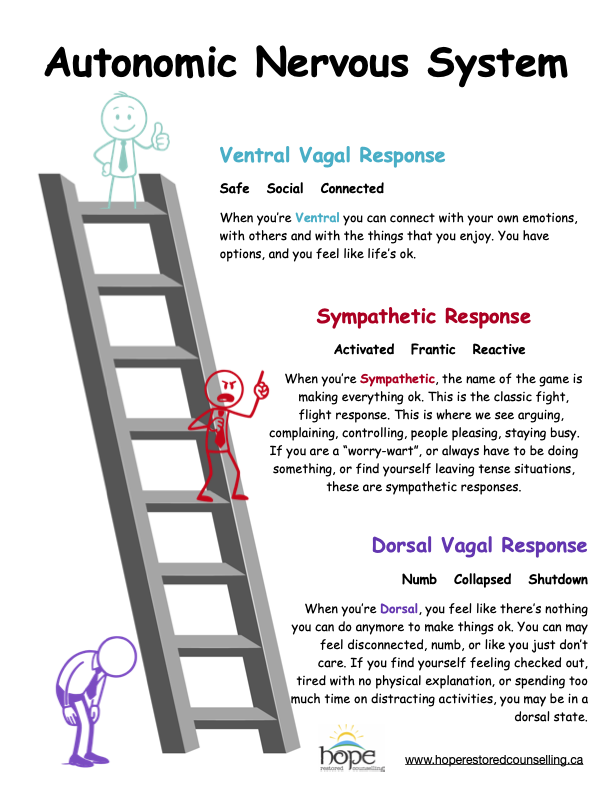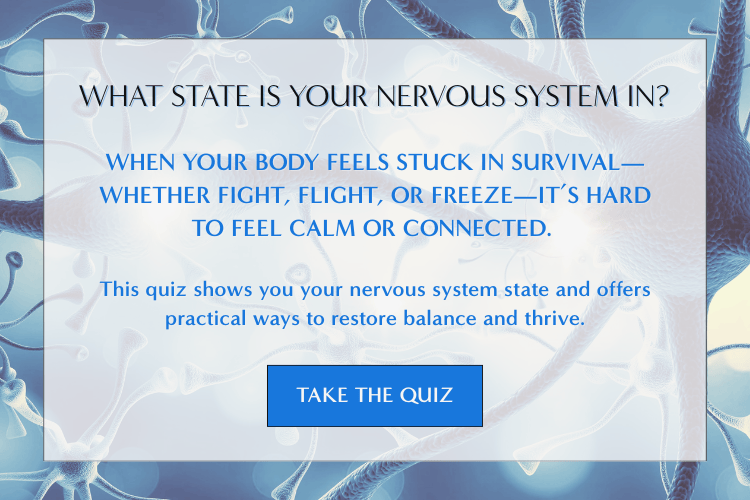Calm Your Nervous System with the Safe Sound Protocol in Canada
What does a calm nervous system look like?
It’s easy to think in terms of what calm doesn’t look like, isn’t it? For instance, if you’re not calm, you might experience things like:
Anger
Depressive symptoms/“the blues”
Jealousy
Feeling like nothing is ever going to go right for you
Being emotionally reactive
Being argumentative
Yeah, ok, that was an easy list to put together, wasn’t it? And we could add, and add, and add to it. But seriously, what might a calm nervous system feel like? Well, here are just a few things you might find:
Feeling deep joy in your relationships
Being able to rest and experience peace
Good health (yes, the calmer our nervous system is, the healthier our body is)
Life’s ups and downs are navigable; which is not the same as enjoyable, but you know you can get through difficulties
Feeling hope where there would otherwise be despair or defeat
Being able to solve problems well
Holding on to your balance in life
Able to enjoy the little things
A few insights you’ll gain in this article:
What your Autonomic Nervous System is and how it works in easy to understand terms
Why it’s helpful to learn about your nervous system
How to recognize what your autonomic state is
How Sound Therapy can help calm your nervous system
That you really can calm your nervous system and enjoy life more!
Meet Your Autonomic Nervous System — Your Body’s Emotional Control Centre
Your nervous system is like your body’s built‑in alarm and comfort system. Without you even thinking about it, it constantly scans the world around you for cues of safety or danger.
When it senses safety, it gives you the green light to relax, connect with others, and think clearly. When it senses danger — whether it’s real or just a reminder of past stress — it flips into protection mode. We recognize this protection mode as survival mode; fight, flight, freeze.
It’s not “all in your head”! This is biology. And the way your nervous system responds shapes how you feel physically, mentally, and emotionally every day.
A Simple Way to Understand Your States
Polyvagal theory, developed by Dr. Stephen Porges, helps us see the nervous system as a ladder that we move up and down on throughout the day. It is here that it gets easier to understand the fight, flight, freeze responses, which I like to call “stress responses”. Learning where you are on this “autonomic nervous system ladder” is the first step toward nervous system regulation. In other words, the first step toward feeling calmer, peaceful, and more in control of your own life.
Here’s a simple way to picture it:
Top of the Ladder — Ventral Vagal (Safe & Social)
This is your “I’m okay” zone
You feel calm, open, connected to others
You can think clearly and respond rather than react
You feel present and grounded
This is the place where you can easily connect with others, with your own emotions, with nature - with the things & activities that make you feel alive
It’s also the place where creativity flows easily, and where you can see a problem and say “No problem, I’ve got this. I’ve got options to get through this hiccup.”
Our goal is to live here as much as possible, returning here easily after the activations that take us down the ladder
Middle of the Ladder — Sympathetic Activation (Fight or Flight)
This is your “Something’s wrong; I need to act now” zone - think of this state as one where action based reactions happen
In sympathetic activation you’re going to do whatever you can to make everything ok
You may experience such things as racing heart, tense muscles, stress sweat, racing thoughts or brain fog, a general difficulty paying attention
It’s not uncommon for people to express ADHD type symptoms of inability to focus or racing thoughts if they spend a lot of their days in sympathetic activation
If this is a place you go to a bit, then this is where you may experience the adrenalin rush that excites & motivates you
You might feel anxious, restless, or irritable, maybe even downright angry
People pleasing and perfectionism (isn’t this in part people pleasing too - or a branch of it?) also are signs of being in sympathetic activation
If you’re a really organized person (think Monica from Friends), and need everything “just so”, then that’s a pretty good indicator that you’re stuck in sympathetic activation a fair bit too
You may find that you always have to be doing something when you’re in the middle of the ladder
Your body’s ready to run away or confront the threat
Bottom of the Ladder — Dorsal Vagal Activation (Shutdown)
This is your “I can’t” zone. There’s nothing I can do to make things ok; there’s no hope that things will get better.
You may feel exhausted, numb, or hopeless
If you find yourself saying “I don’t care”, or “Whatever” quite a bit, does it feel like that’s because nothing will make things OK? Like it doesn’t matter what you want or need?
This is a place where it gets easy to avoid activities or people
You likely lose interest in the things that you have enjoyed in the past; your motivation levels are low
If we think in terms of things we do for relief (to just not feel all the hard stuff anymore), and things we do for restoration (those things that make us feel alive), this is a place where we would tend significantly more toward relief/escape/numbing - this can include things like increased screen time (be it phones, tv or gaming), process addictions like shopping, gambling, pornography, or substance addictions like drugs & alcohol
Life probably feels heavy, overwhelming, or impossible
We all move up and down this ladder—sometimes many times a day. The challenge comes when we get stuck in fight, flight, or shutdown. The good news is that with awareness and practice, you can learn to notice your state and gently guide yourself back toward safety (AKA - feeling like you are going to be ok) and connection.
FAQ
Q1: Is it possible to change my nervous system state?
A1: Yes, it is absolutely possible to change the patterns that your nervous system has fallen into. You can “rewire” your nervous system to go from any default state to one of curiosity, connection and possibilities.
Q2: How can I have a happier life?
A2: For starters, I want to say that it is 100% possible for ANYBODY to enjoy life more! It doesn’t matter how far down the ladder you are, or how long you’ve been there for. The key is to start to developing awareness of your emotions and your system state. There is a roadmap to get to happiness in life, and your desire to get there is the fuel in the engine. You really can do it! And more importantly, you deserve to be happy! (Can you tell I feel pretty passionate about this? 🤩)
Why Calming Your Nervous System Matters for Mental Health
When your nervous system is stuck in survival mode, it can show up as:
Ongoing anxiety or stress
Difficulty sleeping
Feeling on edge or easily triggered (into tears, anger or numbness)
Emotional ups and downs
Trouble focusing or remembering things
Feeling disconnected from yourself or others
By learning to regulate your nervous system, you’re not just calming your body — you’re laying the foundation for better mental health, more stable emotions, and improved physical wellbeing too. There’s a huge, scientifically proven link between our mental/emotional health and our physical health.
Help Your Nervous System Reset with Sound Therapy
The Safe and Sound Protocol (SSP) and Rest and Restore Protocol (RRP) are evidence‑based listening programs designed to help shift your nervous system toward the top of the ladder — the calm, connected state where we feel more alive, and enjoy our relationships and ultimately, our lives.
They work by delivering specially filtered music that gently stimulates the part of your nervous system that helps you feel safe & connected. This isn’t hypnosis or meditation — it’s a non‑invasive, research‑supported approach that works with your body’s natural wiring.
And yes — it’s gentle. You listen for short periods, at your own pace, in the comfort of your home, with guidance from a trained provider.
This feels like a big enough download of info for today, so tune in for my next blog and I’ll share more about how sound therapy works, and what both the Safe & Sound Protocol and the Rest & Restore protocol are and how they can help you get your life back.
Final Thoughts
If you have any desire at all for your life to be better, then you’ve already begun! That is the very first, and most important starting point! Use that longing for more to springboard you into the life you want. It’s never too late, and you’re never too old. Bookmark this post and revisit it every few weeks and see how your self awareness has grown, and notice the shifts in how you feel from one day to the next.
FAQ
Q1: How can sound therapy help me?
A1: Sound therapy can help you feel not only calmer, but also more alive. That “I can” feeling can replace the “that’s just for other people” belief, and you can enjoy life more.
Q2: Can I do sound therapy at home?
A2: Yes! Most people listen to most, if not all of their sound therapy at home. This makes it easier to fit into your life and do in a setting that you already feel comfortable in.
Q3: Can I do my sound therapy online?
A3: Yes you can. There is no need for an in person session to do your sound therapy. We work with individuals all over the world, so there is no barrier based on your location. And better still - if you live in a country with a stronger currency than the Canadian dollar, you get a discount just based on the exchange rate. Cha-ching!
Want to learn more?
Can’t wait for the next blog post to find out how you can start to “live your best life” (sorry, I couldn’t help but throw in the cheesy cliché 😉)?
Book a free consult today. We’ve got time to connect, and why should you wait?!?





